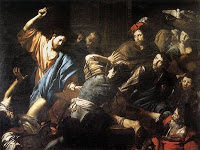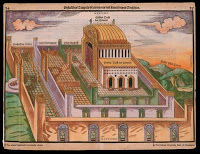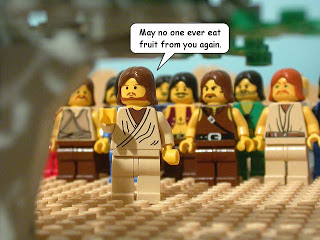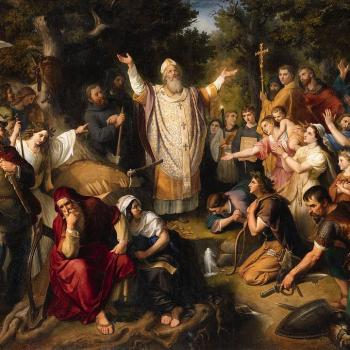Today’s post comes from Sumit Sen, a pastor in the Evangelical Covenant Church. I think this article brings up a lot of great points and would love to hear your thoughts on it.
When one reads Mark 11:12-17 it may seem that the Lord Jesus woke up on the wrong side of the bed. He curses a fig tree when Mark clearly says in verse thirteen that it was not the season for the tree to bear figs, and then He goes into the temple and overturns tables and seats, and allows nobody to carry anything through the temple (v.16). Many scholars have struggled with this incident concerning the fig tree.
Why would the Lord Jesus cursed the tree for not bearing fruit when Mark clearly states that it was not the season for figs?
One calls it a “gross injustice on a tree which was guilty of no wrong.” Another says, “It is a tale of miraculous power wasted in the service of ill-temper.” Do these words such as “gross injustice” and “ill temper” really fit the description of the Lord Jesus Christ we know, Jesus who went about using His power to heal and to restore lives of others? I do not think so.
Therefore, the question is why did the Lord Jesus curse an out of season fig tree for not bearing fruit? As verse thirteen points out the Lord Jesus was not looking for figs. Mark mentions that the Lord went up to see whether perhaps he would find “anything” on it. The key word here is “anything.” If it had been figs Mark would have said so. W. M. Christie, a Church of Scotland minister writing years ago sheds some light on this issue and I quote:
The facts connected with the fig tree are these. Toward the end of March leaves begin to appear, and in about a week the foliage coating is complete. Along with the foliage, and sometimes even before, there appears quite a crop of small knobs, not the real fig, but kind of early forerunner. They grow to the size of green almonds, in which condition they are eaten by hungry peasants and others.
When the Lord Jesus came upon the fig tree it was that time of the season, because it was right before the Lord Jesus was crucified in April. Mark’s emphasis on the fig tree in leaf shows that the tree looked promising. But when the Lord Jesus came to the tree He found nothing, no small knobs or buds to munch on. The tree was barren. The leaves made empty promises when it had nothing to offer. This barrenness, according to some, is the reason that called forth the curse in verse 14, “May no one ever eat fruit from you again.” And as verse 20 tells us in the morning the fig tree was found withered away to its roots.
However, even though the barrenness of the fig tree may provide a reason for cursing, it still does not answer to our satisfaction this only destructive use of Jesus’ miraculous power during the life of His ministry that benefits no one. After all He had healed sinners then why not also heal and not curse a barren fig tree?
Scholars who disagree as to the exact solution to this problem seem to agree that the cursing of the barren fig tree in Mark, in the context of the temple cleansing episode, is an acted out parable symbolizing the failure of God’s people and the temple associated with them to bear the fruit that God requires.
The fig tree on many occasions has served as a symbol pointing to the people of God and their disobedience or their fruitlessness in the Bible (Jer. 8:13; 24:1-10; Hos. 9:10, Mi.7:1, Lk 13:6-9). Therefore, even here the barren fig tree serves as a symbol of God’s people and the temple. This barrenness of the fig tree as we shall see symbolizes the barrenness or the lack of fruitfulness of the temple in Jerusalem, and the actions of the Lord Jesus in the temple that day pointed to the doing away of the temple for a better temple of God. In the OT often the prophetic utterances accompanied actions. Just as in Isaiah 20:2-4 prophet Isaiah’s going naked and barefoot served as a prophetic symbol for God’s judgment on Egypt and Cush, the Lord Jesus’ actions of clearing the temple was also prophetic. It pointed to the end of the temple and its worship in the future.

The Lord Jesus by turning some tables and chairs, and by disrupting the commercial activities for one day did not expect to reform the temple as suggested by some. The same money changers and sellers of doves would have gone back to doing their businesses the very next. Therefore, Jesus’ gestures predicted the end of the temple as he verbally would predict it in Mark 13. But the question is why the temple in Jerusalem needed to go?
A few think that the Lord Jesus’ action was a reaction against commercial malpractice and extortion that was taking place in the temple with the support of religious authority. Others disagree because they do not see a reason why would He drive out the buyers and prevent people from carrying goods through the temple if He was reacting against the corrupt business practices within the temple (15-16).
What Jesus was concerned about is the space and not so much about the practice.
The businesses were taking place in a large area, just inside the temple called the Court of the Gentiles. This is where the Gentiles who revered and feared the God of Israel came to worship Him. The temple was divided into different degrees of holiness. The most holy place was called the Holy of the Holies where only the high priest could go in. Next there was the holy place where the priests could go in and then there was the inner court called the Court of the Israelites for the Israelite males and then the Court of Women. The Court of the Gentiles was the outmost area of the temple. Gentiles could not go beyond this area because they were considered unclean. A barrier with a warning sign kept the gentiles confined to the outer parameter. The warning sign read: “Foreigners must not enter into the forecourt around the sanctuary. Whoever is caught will have himself to blame for his ensuing death.” Yet the religious leaders cluttered this area where gentiles could meet with all kinds of noisy commercial activities. They thought since the place is already unclean because of the presence of the gentiles might as well allow that place for commercial activities.
 But that was not the purpose of the temple of God. For that reason the Lord Jesus quoting from Isaiah 56:7 says in 17a, “Is it not written, ‘My house shall be called a house of prayer for all nations?’” In Isaiah 56:6-8 God is heard saying that He will extend the privilege to foreigners of becoming a part of God’s family and worshipping God in His temple. In fact, when God’s temple was built by King Solomon, Solomon in 1 Kings 8:41-43 says this in his prayer of dedication, “When a foreigner comes and prays…hear from heaven and do according to all that the foreigner calls to you for.” Therefore, when the Lord Jesus uses Isaiah 56:7 here as His justification for His action He is reacting against what the temple had become, i.e. a symbol of Jewish nationalism instead of a gathering place for all nations as intended by God as is made evident from the misuse of the Court of the Gentiles.
But that was not the purpose of the temple of God. For that reason the Lord Jesus quoting from Isaiah 56:7 says in 17a, “Is it not written, ‘My house shall be called a house of prayer for all nations?’” In Isaiah 56:6-8 God is heard saying that He will extend the privilege to foreigners of becoming a part of God’s family and worshipping God in His temple. In fact, when God’s temple was built by King Solomon, Solomon in 1 Kings 8:41-43 says this in his prayer of dedication, “When a foreigner comes and prays…hear from heaven and do according to all that the foreigner calls to you for.” Therefore, when the Lord Jesus uses Isaiah 56:7 here as His justification for His action He is reacting against what the temple had become, i.e. a symbol of Jewish nationalism instead of a gathering place for all nations as intended by God as is made evident from the misuse of the Court of the Gentiles. This failure of the temple to be a house of prayer for all nations in turn pointed to Israel’s missional failure as God’s people to be a light to the Gentiles as God had intended Israel to be all throughout the Old Testament.
-
The universality of the first eleven chapters of the Bible in Genesis matches well with the last few chapters in the Bible where we read about people from all nations being gathered to worship God (Rev.7:9). The Bible, from the beginning to the end, is about people from all nations and tribes. If the first eleven chapters of Genesis deal with the creation, fall and corruption of the world, the rest of the Bible can be seen as God’s attempt through Israel and through Israel’s Messiah to reconcile the world to Himself. Therefore, God called Abraham in Genesis 12:1-3 to be a blessing to all the families of the earth. Victor Hamilton sees this as God’s programmatic statement; that it is to bless through Abraham the corrupt nations and people such as those mentioned in Genesis 3-10.
-
Secondly, the Hebrew kol mispehot in verse 3 is properly translated as all people or families. Therefore, the blessing of God was meant to be so pervasive that it would reach not only people groups but even the smallest unit of society. This idea of being a blessing is also transferred to Abraham’s progeny Israel. In Exodus 19:6 Israel is called to be a Kingdom of Priests and a Holy Nation. Israel as a “Kingdom of Priests” meant the way God was going to use Israel in relation to other nations. As a Priestly Nation Israel was called also to be Holy, they were not to be like theses other nations (Lev.18:1-5) and were supposed to bring the knowledge of God to these nations. By calling Israel to be such a favored nation, God was not just pointing to Israel’s privileged place in God’s scheme of things but was also pointing to the international side of Israel’s vocation. Israel was also called to be a blessing and a light to the nations in keeping with the promise made by God to Abraham (Is. 42:1-6). As Abraham assumed a priestly role in Genesis 18 when he pleaded to God to do justice in the case of Sodom and Gommorah, Israel was to assume the priestly role of standing before God on behalf of nations and standing before the nations on behalf of God.
 However, something happened to Israel’s vocation as a light to the Gentiles in the course of time. First instead of being a light they embraced the darkness that surrounded other nations by committing idolatry. In Ezekiel 20:32 we hear the very thought of Israel exposed, “Let us be like other nations and worship wood and stone.” Israel fell into the temptation of syncretism and worshiped other gods such as the fertility god of storm called Baal and the “high places” where they worshipped were symbolic of the nipples of the breasts of mother earth, upraised to meet her Baal. They indeed became like other nations. The servant of Isaiah 42:4, who was called to be a light to the world became one with the darkness of the world. As a result their mission as God’s light to the nations of the world was lost, and God sent them into exile. However, if syncretism and their desire to become like other nations first contributed to the loss of Israel’s sense of mission to the world, the second factor that contributed to their loss of this sense of mission to a large extent is the attitude of separatism that took over many in Israel after the exile. When Babylon was destroyed by Persia and King Cyrus of Persia asked the Jews to go home, they returned home to rebuild their nation and rebuilt another temple with a very different attitude. The pre-exilic times had left a bad taste in their mouth; they remembered how their idolatry and engagement with other nations had started the downfall of the nation of Israel. Therefore, when they returned they wanted to have nothing to do with foreign nations. In Ezra 4:12 we read that when the neighboring people, the Samaritans approached the people of Judah to help them build their temple and worship their God, the Jews replied, “You have nothing to do with us in building a house to our God; but we alone will build to the LORD, the God of Israel, as King Cyrus the king of Persia has commanded us.” By the time of Jesus, the attitude of the average Jew toward the Gentiles was almost exclusively negative. The general hostilities of the Gentiles toward the Jews produced corresponding bad feelings and hatred of Jews toward the Gentiles. Years of war, defeat and foreign occupations embittered the Jews toward the Gentiles. The more the Jews emphasized their election, their status as God’s people, the more they became hateful towards those who were not. It was said that if a man gave his daughter in marriage to a Gentile he committed a capital offense. Gentiles were considered children of destruction, and killing a Gentile was counted as righteousness. In fact, imbeciles, Gentiles and Samaritans were all lumped together in one category.
However, something happened to Israel’s vocation as a light to the Gentiles in the course of time. First instead of being a light they embraced the darkness that surrounded other nations by committing idolatry. In Ezekiel 20:32 we hear the very thought of Israel exposed, “Let us be like other nations and worship wood and stone.” Israel fell into the temptation of syncretism and worshiped other gods such as the fertility god of storm called Baal and the “high places” where they worshipped were symbolic of the nipples of the breasts of mother earth, upraised to meet her Baal. They indeed became like other nations. The servant of Isaiah 42:4, who was called to be a light to the world became one with the darkness of the world. As a result their mission as God’s light to the nations of the world was lost, and God sent them into exile. However, if syncretism and their desire to become like other nations first contributed to the loss of Israel’s sense of mission to the world, the second factor that contributed to their loss of this sense of mission to a large extent is the attitude of separatism that took over many in Israel after the exile. When Babylon was destroyed by Persia and King Cyrus of Persia asked the Jews to go home, they returned home to rebuild their nation and rebuilt another temple with a very different attitude. The pre-exilic times had left a bad taste in their mouth; they remembered how their idolatry and engagement with other nations had started the downfall of the nation of Israel. Therefore, when they returned they wanted to have nothing to do with foreign nations. In Ezra 4:12 we read that when the neighboring people, the Samaritans approached the people of Judah to help them build their temple and worship their God, the Jews replied, “You have nothing to do with us in building a house to our God; but we alone will build to the LORD, the God of Israel, as King Cyrus the king of Persia has commanded us.” By the time of Jesus, the attitude of the average Jew toward the Gentiles was almost exclusively negative. The general hostilities of the Gentiles toward the Jews produced corresponding bad feelings and hatred of Jews toward the Gentiles. Years of war, defeat and foreign occupations embittered the Jews toward the Gentiles. The more the Jews emphasized their election, their status as God’s people, the more they became hateful towards those who were not. It was said that if a man gave his daughter in marriage to a Gentile he committed a capital offense. Gentiles were considered children of destruction, and killing a Gentile was counted as righteousness. In fact, imbeciles, Gentiles and Samaritans were all lumped together in one category.

This negative attitude toward Gentiles unfortunately came to be reflected in the life of the temple as well, as is evident from the temple cleansing incident in Mark. The temple had lost its mission, it had ceased to be a house of prayer for all nations. Instead, the Lord Jesus says in 17b the temple has become a den of robbers. Some scholars think that the Lord Jesus was referring to the dishonest business practices in the temple. But, in fact, the Lord Jesus was calling the temple a robbers’ den and not the place where robbers do their robbery. The robber’s den is the place where robbers feel comfortable and safe; it is the place where robbers retreat after committing a crime. In fact, here the Lord Jesus quotes Jeremiah 7:8-14 where the prophet Jeremiah accuses the people of Israel of turning the house of God, the temple into a den of robbers where they feel safe. In verses 8-10 of this passage in Jeremiah we read that while the people went about murdering, committing adultery, swearing falsely and worshipping Baal they would come to the temple and say they were safe. Their safety net was the temple sacrifices they offered for their sins. The people thought that they could find forgiveness and fellowship with God in the temple no matter how they acted outside. The same thing was happening in the Lord Jesus’ time, the temple in fact had become a place of comfort for people who lived a dishonest life outside day after day. It had become a place for people to run to, to offer prescribed sacrifices to atone for their sins while outside they lived a life of immorality which included hatred and prejudice toward fellow human beings such as the Gentiles. They felt that through the sacrifices they would find forgiveness and fellowship with God no matter how immoral they had been out in the society. In that sense the temple offered them a false sense of security like a den does for the robber.

The temple’s purpose was to bring people to God, and inspire godly living which included living missionally and shinning the light of God to others. But, in every respect the temple as a reflection of the corrupt religious leaders that ran it failed to deliver. It not only failed to be a mission outpost for God, but also gave a false sense of security to those who refused to live missionally in their community, i.e. as God’s light to the world. As a result the temple was found barren. Therefore, the prophetic actions of the Lord Jesus in the temple that day pointed to the demise of the temple. The Lord Jesus was prophesizing an end of the temple days and its sacrifices, because God was going to make Himself a new temple that would fulfill His desire to bless the world through Abraham. In AD 70 the temple in Jerusalem was destroyed. But a new temple of God lived on in the resurrected body of the Lord Jesus who in regards to the blessing to the Gentiles is regarded by Paul as the offspring of Abraham (Gal.3:15-16). In John 2:19-21 the Lord Jesus refers to His body as the temple and in 1Cor. 3:16 church which is the body of Christ is also regarded as the temple of God. The body of Christ where God’s presence is manifested and where the forgiveness of sin through the blood and the body of Christ is made available has become the temple, i.e. the center of true worship. It is also in this temple of God, Apostle Paul says in Ephesians 2:14 that the Lord Jesus has made peace between Jews and Gentiles by breaking down the dividing wall, that is, the hostility between us (probably referring to the wall in the Jerusalem temple that separated the Court of the Gentiles from the rest). The Church as the body of Christ is the temple that has been called to become truly a house of prayer for all nations.
The question is, have we? Does our church show openness or more importantly opening up to diversity? Gentiles in our world may be the seeking or not seeking non- Christians. Does our church work consciously on addressing and removing barriers that might keep a non-Christian from coming to God? Do we do Church with non-Christians in mind? Or has our notion of justification by grace only through faith only become our “den of robbers” a comfort zone that has robbed us of missional living by lulling us into doing nothing or living irresponsibly in the realm of God?
- Lane William. The Gospel of Mark (NICNT). Grand Rapids: Eerdmans 1974, pp.399 n.24.
- Gundry, Robert H. Mark: A Commentary on his Apology for the Cross. Eerdmans: Grand Rapids, 1993, pp.636.
- Hard Sayings of the Bible. IVP: Downers Grove, 1996, pp. 442.
- James A. Brooks in his commentary on Mark (NAC) points out destruction of pigs (Mark 5:11-13) as the only other miracle of destruction by Jesus. But important dissimilarities exist between the fig tree and pigs incident. Fig tree incident benefits no one and in the pigs incident demons are responsible for the destruction.
- France, R.T. The Gospel of Mark: NIGTC. Eerdmans: Grand Rapids, 2002, pp. 439-441
- Elwell, Walter A. Yarbrough, Robert W. Readings from the First-Century World. Grand Rapids: Baker 2004, pp. 70-71.
- Hamilton, Victor P. The Book of Genesis. Grand Rapids: Eerdmans 1990, pp. 374.
- Kaiser, Walter c. Mission in the Old Testament: Israel as a Light to the Nations. Grand Rapids: Baker, 2000, pp.19.
- Enns Peter, Exodus:NIVAC. Grand Rapids: Zondervan 2000, pp. 389.
- Glasser, Arthur F. Announcing the Kingdom: The Story of God’s Mission in the Bible. Grand Rapids: Baker, 2003, pp.64.
- Ibid. 115.
- Elwell, Walter A. Yarbrough, Robert W. Readings from the First-Century World. Grand Rapids: Baker 2004, pp. 70-71.
- Garland, David E. Mark (NIVAC). Grand Rapids: Zondervan, 1996, pp. 439.
 But that was not the purpose of the temple of God. For that reason the Lord Jesus quoting from Isaiah 56:7 says in 17a, “Is it not written, ‘My house shall be called a house of prayer for all nations?’” In Isaiah 56:6-8 God is heard saying that He will extend the privilege to foreigners of becoming a part of God’s family and worshipping God in His temple. In fact, when God’s temple was built by King Solomon, Solomon in 1 Kings 8:41-43 says this in his prayer of dedication, “When a foreigner comes and prays…hear from heaven and do according to all that the foreigner calls to you for.” Therefore, when the Lord Jesus uses Isaiah 56:7 here as His justification for His action He is reacting against what the temple had become, i.e. a symbol of Jewish nationalism instead of a gathering place for all nations as intended by God as is made evident from the misuse of the Court of the Gentiles.
But that was not the purpose of the temple of God. For that reason the Lord Jesus quoting from Isaiah 56:7 says in 17a, “Is it not written, ‘My house shall be called a house of prayer for all nations?’” In Isaiah 56:6-8 God is heard saying that He will extend the privilege to foreigners of becoming a part of God’s family and worshipping God in His temple. In fact, when God’s temple was built by King Solomon, Solomon in 1 Kings 8:41-43 says this in his prayer of dedication, “When a foreigner comes and prays…hear from heaven and do according to all that the foreigner calls to you for.” Therefore, when the Lord Jesus uses Isaiah 56:7 here as His justification for His action He is reacting against what the temple had become, i.e. a symbol of Jewish nationalism instead of a gathering place for all nations as intended by God as is made evident from the misuse of the Court of the Gentiles.  However, something happened to Israel’s vocation as a light to the Gentiles in the course of time. First instead of being a light they embraced the darkness that surrounded other nations by committing idolatry. In Ezekiel 20:32 we hear the very thought of Israel exposed, “Let us be like other nations and worship wood and stone.” Israel fell into the temptation of syncretism and worshiped other gods such as the fertility god of storm called Baal and the “high places” where they worshipped were symbolic of the nipples of the breasts of mother earth, upraised to meet her Baal. They indeed became like other nations. The servant of Isaiah 42:4, who was called to be a light to the world became one with the darkness of the world. As a result their mission as God’s light to the nations of the world was lost, and God sent them into exile. However, if syncretism and their desire to become like other nations first contributed to the loss of Israel’s sense of mission to the world, the second factor that contributed to their loss of this sense of mission to a large extent is the attitude of separatism that took over many in Israel after the exile. When Babylon was destroyed by Persia and King Cyrus of Persia asked the Jews to go home, they returned home to rebuild their nation and rebuilt another temple with a very different attitude. The pre-exilic times had left a bad taste in their mouth; they remembered how their idolatry and engagement with other nations had started the downfall of the nation of Israel. Therefore, when they returned they wanted to have nothing to do with foreign nations. In Ezra 4:12 we read that when the neighboring people, the Samaritans approached the people of Judah to help them build their temple and worship their God, the Jews replied, “You have nothing to do with us in building a house to our God; but we alone will build to the LORD, the God of Israel, as King Cyrus the king of Persia has commanded us.” By the time of Jesus, the attitude of the average Jew toward the Gentiles was almost exclusively negative. The general hostilities of the Gentiles toward the Jews produced corresponding bad feelings and hatred of Jews toward the Gentiles. Years of war, defeat and foreign occupations embittered the Jews toward the Gentiles. The more the Jews emphasized their election, their status as God’s people, the more they became hateful towards those who were not. It was said that if a man gave his daughter in marriage to a Gentile he committed a capital offense. Gentiles were considered children of destruction, and killing a Gentile was counted as righteousness. In fact, imbeciles, Gentiles and Samaritans were all lumped together in one category.
However, something happened to Israel’s vocation as a light to the Gentiles in the course of time. First instead of being a light they embraced the darkness that surrounded other nations by committing idolatry. In Ezekiel 20:32 we hear the very thought of Israel exposed, “Let us be like other nations and worship wood and stone.” Israel fell into the temptation of syncretism and worshiped other gods such as the fertility god of storm called Baal and the “high places” where they worshipped were symbolic of the nipples of the breasts of mother earth, upraised to meet her Baal. They indeed became like other nations. The servant of Isaiah 42:4, who was called to be a light to the world became one with the darkness of the world. As a result their mission as God’s light to the nations of the world was lost, and God sent them into exile. However, if syncretism and their desire to become like other nations first contributed to the loss of Israel’s sense of mission to the world, the second factor that contributed to their loss of this sense of mission to a large extent is the attitude of separatism that took over many in Israel after the exile. When Babylon was destroyed by Persia and King Cyrus of Persia asked the Jews to go home, they returned home to rebuild their nation and rebuilt another temple with a very different attitude. The pre-exilic times had left a bad taste in their mouth; they remembered how their idolatry and engagement with other nations had started the downfall of the nation of Israel. Therefore, when they returned they wanted to have nothing to do with foreign nations. In Ezra 4:12 we read that when the neighboring people, the Samaritans approached the people of Judah to help them build their temple and worship their God, the Jews replied, “You have nothing to do with us in building a house to our God; but we alone will build to the LORD, the God of Israel, as King Cyrus the king of Persia has commanded us.” By the time of Jesus, the attitude of the average Jew toward the Gentiles was almost exclusively negative. The general hostilities of the Gentiles toward the Jews produced corresponding bad feelings and hatred of Jews toward the Gentiles. Years of war, defeat and foreign occupations embittered the Jews toward the Gentiles. The more the Jews emphasized their election, their status as God’s people, the more they became hateful towards those who were not. It was said that if a man gave his daughter in marriage to a Gentile he committed a capital offense. Gentiles were considered children of destruction, and killing a Gentile was counted as righteousness. In fact, imbeciles, Gentiles and Samaritans were all lumped together in one category.















